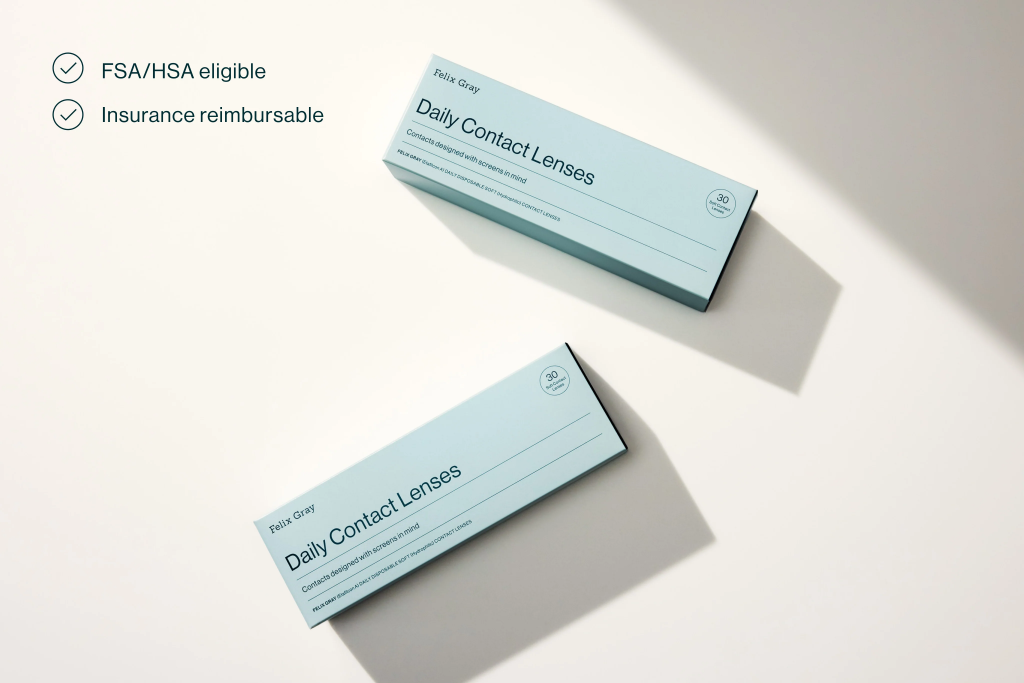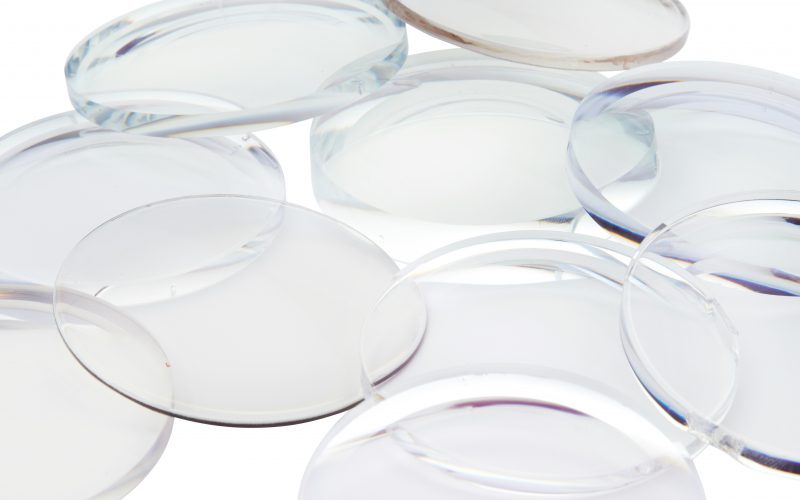Have you been toying with the idea of switching over from your regular specs to contact lenses? Then knowing just how much it’s going to cost (and how to plan for these costs) can be incredibly important.
But before you start to break into a cold sweat over making the switch, you can let out that breath you’ve been holding. At Felix Gray, we’ve got you covered!
This quick and easy guide contains the A to Z of what to consider when you’re buying contacts, and how this can affect their price. So, you’ll be adequately informed when you’re ready to ditch the frames and embrace your new contacts. Let’s get into how much contacts cost.
Types Of Contact Lenses And Their Cost
Understanding the different types of contact lenses and their costs is really important in helping you make a more informed decision.
From daily disposables to monthly contacts and specialized lenses, you’ll find all the information you need on pricing and features below.
Daily disposable contact lenses

Daily disposable contact lenses offer you the most convenience since they let you use a fresh pair every day without the need for cleaning or storage. But this convenience can come at a cost. Unless you buy daily contacts from Felix Gray, that is! We keep our prices as low as possible to ensure everyone can access the eyecare they need.
Average cost: Typically, you can expect to pay between $0.85 and $1.25 per day, but this cost may be slightly higher or lower depending on the brand you’re buying. It can also be cheaper to subscribe to a monthly service like the one offered by Felix Gray. With this, you’ll receive a one-month supply that costs less and is even more convenient.
What to consider: While disposables may seem more expensive up front, their benefits in terms of convenience and overall eye health can sometimes outweigh their cost.
Biweekly contacts
Biweekly contacts are a great middle-ground if you don’t want to wear your contact lenses for too long but also don’t want to use fresh ones every day. This is because they can be worn for two weeks at a time.
Average cost: You’re going to want to budget around $0.70 to $1.20 per day for biweekly lenses, making them only slightly cheaper than your average daily disposable lenses.
What to consider: Less frequent changes mean a whole lot less hassle, but you’re still generally paying more than what you’d pay for monthly contact lenses.
Monthly contacts
Monthly disposable lenses are designed to be worn for up to 30 days, which means you’ll only need to replace them once a month! However, they do need to be stored and cleaned properly to keep them in good condition.
Ultimately, monthly lenses are a great way to enjoy convenience (in terms of replacements) and cost-effectiveness.
Average cost: Around $0.55 to $0.90 per day, making them much cheaper than daily disposable lenses and biweekly lenses in the long run.
What to consider: While monthly contact lenses need a little more maintenance than daily disposables, their low cost makes them a great choice if you’re on a budget.
Toric and multifocal contacts
Toric contacts and multifocal lenses usually cater to very specific vision needs like astigmatism (a curve of the eye) and presbyopia (age-related focus issues). These contact lenses are typically customized, much like the lenses of prescription eyeglasses.
Average cost: Specialized lenses can cost anywhere from $1 to $4 per day, depending on the customization required.
What to consider: Although these lenses can become pretty pricey, they’re necessary to correct vision impairments for specific eye conditions.
Factors Influencing The Cost Of Contact Lenses
Ever wondered why your contact lenses cost so much? Or why the cost changes depending on which lenses you get? Well, there are a few things to consider when it comes to pricing, including the lens type and material it’s made out of, your prescription, and much more.
Lens type and material
So we’ve already spoken about the different types of lenses above, with each type having different costs. But did you know that contact lenses come in different materials as well? This is another factor that could make your lenses cheaper (or more expensive).
Contact lenses can be made from various materials, although the two most commonly used are soft hydrogel and silicone hydrogel. Soft contact lenses are usually the most affordable, while specialized materials like gas-permeable (rigid) lenses come with a slightly higher price tag. This is because of their custom design and longer lifespan.
Prescription complexity
The complexity of your specific contact lens prescription can impact the cost of your lenses in several ways. Firstly, certain prescriptions, like those for astigmatism, usually require that the lenses be custom-made. This can add to the overall expense because it adds additional steps to the manufacturing process.
Secondly, specialized prescriptions like toric contacts may be much more intricate to produce. In turn, this leads to higher production costs that push up the price of the final product – your contact lens.
Lastly, some prescriptions necessitate that the lenses be made from specific materials. Or, in some rare cases, they may need to be produced using special technologies, which will make the cost of your lenses much higher.
Brand
Like almost anything else, the brand of your contact lenses can impact their cost. For example, more established brands with a reputation for reliability and quality may have a higher price tag.
These high-quality brands usually invest in research and development, though, to keep their customers happy, which means their products are always being improved.
Additional features
Some contact lenses offer additional features like UV protection to shield your eyes from harmful ultraviolet (UV) rays. This can help prevent eye conditions or health complications like cataracts and macular degeneration. Plus, UV protection can come in handy for outdoor enthusiasts or anyone with light-sensitive eyes!
While this is a great feature to have, it unfortunately also drives up the overall cost of contact lenses.
Budgeting For Contact Lenses
If you’ve just been given a new prescription for contact lenses, then you’re going to want to plan out your budget for this expense. Luckily, it’s a lot simpler than it sounds! And, with our tips, you’ll have everything you need to ensure the affordability of your lenses.
Budgeting tips
If you want to budget more effectively for your contact lenses, then be sure to follow these five easy steps:
Compare prices: Before you buy your lenses, try to shop around to find the best prices. Remember, you’ll want to try a few different stores and brands to see what suits you best. That way, you can ensure that you’re getting the most value for your money.
Buy lenses in bulk: Most lens boxes come in packs of 30, 60, or 90. The more you buy, the less you’re going to pay for your contacts per day! So, if you can buy a bigger box of lenses, then you’re definitely going to be saving money in the long run.
Choose a generic brand: Just because a product has a brand name doesn’t mean that it’s necessarily better than a genetic pair of contacts. While you want to be wary of the materials and quality of the contacts you’re getting, replacing your more expensive brands with generic alternatives is a great way to save money.
Keep an eye out for promotions: Manufacturers often have rebates or promotions on contact lenses, so you’ll want to keep your eyes peeled for any good deals.
Set funds aside: Even if you don’t buy your lenses once a month, you should set some money aside to help pay for them when it’s necessary. For example, if you buy three months’ worth of lenses and put money aside for three months to help you pay for them, then the upfront cost is much less daunting!
Insurance
Besides being vigilant about your budget, having vision insurance can help to reduce any out-of-pocket expenses you may have when paying for your contacts. In fact, your insurance provider may even cover your routine eye exams and a contact lens fitting, and even partially pay for your lenses themselves.
To find out what your specific vision insurance plan covers, you’ll want to contact your insurance provider. They’ll be able to advise you on what they cover and any additional expenses you may not have to worry about!
FAQs
Are contact lenses cheaper than glasses?
Both contact lenses and glasses can differ in cost depending on the brand, your prescription, and the material. But glasses may actually be cheaper in the long run, since they are not constantly being replaced.
Sure, you may need to replace your glasses when you need new lenses fitted. But this is an occasional rather than ongoing expense!
Still, the choice between glasses and contacts is extremely personal. If glasses are uncomfortable and you prefer the feel of contact lenses, you can always opt for the latter.
Are contact lenses better than glasses?
Contact lenses aren’t any better or worse for vision correction than glasses. So, you can choose your contact lenses based on your preferences rather than which option is ‘better’.
Are more expensive contact lenses better quality?
Not necessarily! Some generic lenses are just as good (if not better, in some cases) than branded lenses. The only difference is the quality assurance that comes with buying your lenses from a reliable and high-quality brand.
Final Thoughts
Ultimately, contacts can be super affordable if you know how to budget for them (and what to consider when you’re working out your monthly cost!). Just remember: when you need specialized lenses, the average cost of contact lenses is much higher. So, if you have an eye health condition or need specific vision correction, then you may want to consider a sleek pair of glasses instead.
